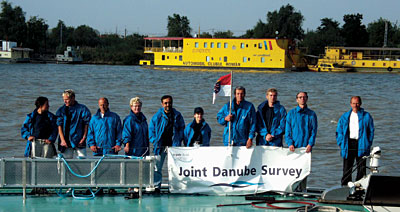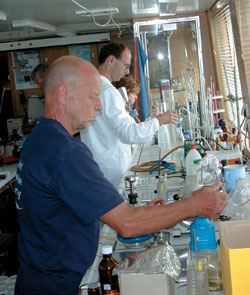The Danube, a river that connects 13 European countries, has always been a centre of attention of people living within its basin. It is a source of water for millions of inhabitants as well as an important trade route and fishing and recreational zone. The quality of the Danube water has been carefully kept under observation by scientists, regulatory bodies and politicians in all Danube countries. The official start of the joint co-operation of Danube countries in water quality monitoring dates back to 1985 when the Bucharest Declaration was signed. Since 1996 a regular monitoring of the water quality has been performed under the ICPDR after the Trans-National Monitoring Network (TNMN) in the Danube River Basin had been established. Under the TNMN the countries share their results on the Danube pollution.
However, Danube environmental scientists kept pointing out that a survey should be performed in which samples from the whole stretch of the Danube would be collected and analysed in a single laboratory. The main reason for such an investigation would be to ensure a high comparability of results because all samples would be taken in a uniform way and variations of data between different laboratories would be avoided. Similar trials have been carried out in the past twenty years by various organisers (IAD, Equipe Cousteau, Burgund survey), but they focused only on certain stretches of the Danube or only on selected groups of parameters.
In summer 2001 the dream of many friends of the Danube became a reality. A team of ten scientists from Germany, Austria, Slovakia, Hungary, Yugoslavia, Bulgaria and Romania boarded in Regensburg the fleet formed by Argus and Szechenyi ships and started their six-weeks' journey towards the Black Sea.

A dream turns into reality.
The team followed a carefully prepared sampling plan, stopping at 98 selected river cross-sections and taking samples of water, bottom sediments, suspended solids and mussels. At the same time biologists were gathering a rich collection of animals and organisms living on the river bottom, macro- and microalgae attached to stones and soft sediments, water plants, algae, bacteria and floating animals carried by water. Some of the parameters, such as pH, nitrites or chlorophylla were measured in the water directly after sampling on-board the laboratory ship Argus. The rest of the samples were carefully preserved, stored and sent in regular intervals first to the JDS Central Storage facility at VITUKI in Budapest and then re-distributed to the nine JDS Reference Laboratories in Germany, Austria, Slovakia and Hungary. These labs were selected as centres of excellence for analysis of particular water quality parameters.
During its journey downstream the Danube the survey attracted a lot of attention. It was followed by journalists and TV crews in all countries and usually made it into the headlines of the major newspapers, radio broadcasting and TV news. For the scientists and crew it was a rather new experience to be welcomed upon entering a country by music bands, champagne, bread and salt or majorettes. It was convincing and pleasant evidence that the environmental concern expanded from the scientific and administrative institutions to the public and that the common people shared the interest in the fight for a clean Danube.
 |
|
| Analysing samples on board. |
Each participating Danube country supported the survey also by establishing a national team of experts, which worked along with the international JDS experts on their national stretch of the Danube. It was great to see the sincere effort of Yugoslavian and Croatian colleagues renewing their common trans-boundary sampling and working together for the first time since 1990 in the areas devastated by war. Still, as a memento of the past, the scenes of bombed bridges in Novi Sad enlightened by the pouring thunderstorm will surely remain for a long time in the memory of all scientists and crew aboard Argus and Szechenyi ships.
For those joining the JDS team, having to work from 6 or 7 a.m. till late in the evening and being stuck on the ships most of the time, might not have been a very attractive first impression. Despite the relatively hard conditions, most of the experts from national teams would have liked to extend their stay aboard the ships and continue the journey all the way to the Danube delta. And they really missed something great because it was quite an excitement when Captain Manfred Wenner victoriously announced "kilometer zero" on the microphone. The 2581-km-long journey that started in Germany on a sunny August day was over and in front of Argus was an undisturbed horizon of the Black Sea. As everything must be deserved, much of the way back from kilometer zero upstream the delta was sailed in complete darkness and the ship at one point almost got stranded in the shallow water of a Danube arm. However, Poseidon himself must have taken care of the crew because not a single soul was lost nor did anyone miss the farewell party. As the last goodbye, one more sampling point next day, the last "staatioon" shout by the team leader, Peter Literathy, and the Joint Danube Survey 2001 was over. Not so the work awaiting the scientists! After coming back, members of the JDS team together with other ICPDR experts immediately started gathering vast amounts of data from the laboratories in order to prepare the final report, which is expected to be available to the public in summer 2002. All those involved in the JDS strongly believe that this unique expedition worth over 1.2 million DEM and funded by Germany and Austria will form a solid, long-term basis for decision making related to the water quality in the Danube River Basin.
The ICPDR is grateful to all those who contributed to the success of the survey: the supporting governments, the co-operating ICPDR experts and especially to those who were there - JDS Core Team members, captains and crews on Argus and Szechenyi as well as the JDS National Teams. Without this large group of enthusiastic Danube friends the survey would have remained only a dream.
